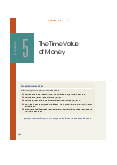





Preview text:
See discussions, stats, and author profiles for this publication at: https://www.researchgate.net/publication/277309963
Customer Journeys: Involving Customers and Internal Resources in the Design and Management of Services. Conference Paper · April 2014 CITATIONS READS 7 13,603 3 authors: Asbjørn Følstad Knut Kvale SINTEF Telenor
115 PUBLICATIONS2,967 CITATIONS
49 PUBLICATIONS754 CITATIONS SEE PROFILE SEE PROFILE Ragnhild Halvorsrud SINTEF Digital
37 PUBLICATIONS671 CITATIONS SEE PROFILE
Some of the authors of this publication are also working on these related projects: Media Policy View project Design Thinking View project
All content following this page was uploaded by Asbjørn Følstad on 28 May 2015.
The user has requested enhancement of the downloaded file.
This is an author's accepted manuscript of an article published in Proceedings of
ServDes 2014 (pp. 412-417). Available online at: http://www.ep.liu.se/ecp/099/042/ ecp14099042.pdf.
Customer journeys: Involving customers and
internal resources in the design and management of services Asbjørn F ølsta t d1, K n K ut K v K a e2, Rag hild H alvo srud1 Kv al e , Rag nhil Halvorsr d
asbjorn.folstad@sintef.no, knut.kvale@telenor.com, ragnhild.halvorsrud@sintef.no 1) 2)
SINTEF, Oslo, Norway. Telenor, Bærum, Norway Abstract
The customer journey approach is increasingly being t aken up by practitioners and researchers
to support the design and management of services. As part of this approach, customers and
internal resources are often involved as contributors of input i n design and management
processes. In the current literature on customer journeys, a broad variety of involvement
practices has emerged. No coherent framework has been proposed to structure these practices. In this short-paper, we p
rovide an overview of the different purposes and implementations of
emerging involvement practices with the customer journey approach. We then contribute a
simple framework for these practices, where we classify involvement according to its purpose,
implementation, and output. Finally, we point out future research needed to further develop
the ways customers and internal resources are involved within the customer journey approach.
KEYWORDS: Customer journeys, service design, customer involvement, methods Introduction
The customer journey approach has generated much interest in fields concerning the design
and management of services. In a recent McKinsey report, Stone and Divine (2013) argue that
the customer journey approach represents a needed paradigmatic shift in how we understand a
customer's experience of a service. Zomerdijk and Voss (2010), in a study of successful
experiential service providers, found customer journeys to be widely used in the design and
management of services. Likewise, Segelström and Holmlid (2009), found customer journeys
to be a prevalent approach to structure early phase user research in service design projects.
A number of practices have emerged concerning the involvement of customers and internal
resources, that is, personnel internal to the service provider, in customer journey work. Such
involvement is conducted for a wide range of purposes and conducted in a variety of ways,
such as, for example, the mapping of customer journeys with customer representatives
(Croiser & Handford, 2012), the mapping and redesign of customer journeys with company
internals (Wechsler, 2012), the co-design of customer journeys with customers (Kankainen,
Vaajakallio, Kantola, & Mattelmäki, 2012), and the measurement of customer satisfaction for
key customer journeys (Rawson, Duncan & Jones, 2013). This variation in purposes and
involvement practices reflect the versatile character of the customer journey approach.
However, in the face of such variation it seems appropriate to establish a framework to get
an overview of the different purposes and implementations as well as to foster a common
understanding of how the involvement of customers and internal resources may be
conducted within the customer journey approach.
In this paper, we provide an overview of involvement practices that has emerged within the
customer journey approach. On the basis of this overview, we provide a s imple framework to
systematize these practices. Finally, we use the framework to highlight needed future research.
The presented overview springs from a systematic literature review of customer journeys in
the scientific literature, a preliminary version of which is presented in an open technical
report (Følstad, Kvale & Halvorsrud, 2013). Due to space limitations we do no tgo into
detail on the review here. The interested reader is referred to the technical report. What are customer journeys?
The concept of customer journeys has been used, at least since the early nineties, to describe
services from the customer's point of view (Whittle & Foster, 1991). Nevertheless, the
literature on customer journeys is still in its emergence, though some key works (Parker &
Heapy, 2006; Voss & Zomerdijk, 2007) have made a marked impression on the field. As of
yet, we have not reached a point of stable definitions and uses of key terminology associated
with customer journeys (Følstad et al., 2013).
In the literature, a customer journey is seen as the process that a customer goes through to
reach a specific goal, that involves one or more service providers (Følstad et al. 2013).
Customer journeys are typically detailed as a series of touchpoints or interactions between
the customer and the service providers (for example, Clatworthy, 2011; Stickdorn & Zehrer,
2009). The importance of a customer journey perspective increases as the complexity in
service provisioning increase ,
s for example, when services involve multiple touchpoints for
which different organizational units are responsible (Wechsler, 2012).
Overview of involvement practices within the customer journey approach
A variety of practices for involving customers and internal resources in the analysis and
design of customer journeys is describe d in the literature.
Involvement practices to support analysis, that is, the gathering and processing of data
concerning existing customer journeys, are much reported in the literature. Proponents of
such analysis are, for example, Croiser and Handford (2010) who, on the basis of data
gathered from customer observation and interviews map customer journeys as they are
experienced by their participants. Or, for example, Wechsler (2012) who describes
workshops with internal resources for collaborative mapping of touchpoints and customer ServDes. 2014
Fourth Service Design and Innovation conference
journeys. The mapping of customer journeys typically has an exploratory character, wit h
qualitative methods for data collection to allow for surprise insights.
The analysis of customer journeys may also concern quantitative measurement of the
customer's experience. In the scientific literature, such measurement is typically conducted as
part of the mapping process to quantify changes in experiential quality during the customer
journey (Trischler & Zehrer, 2012). However, measurements of customers' experiences
during a customer journey may also be conducted on a routine basis, without being
associated with an ongoing mapping process (Rawson et al., 2013). Quantitative
measurements are, for example, implemented as questionnaires.
The customer journey approach also encompasses involvement practices targeting the
creative phase of the design process, in particular, through co-design activities. Clatworthy
(2011) describes, as one of the purposes of the AT-ONE service design method, how
internal resources may be engaged in the co-design of services through deliberate rearranging
the sequence of touchpoints in a customer journey map. Kankainen et al. (2012) report on
the use of customer journeys for co-design, where customers formulate "dream journeys".
The co-design activities reported by Kankainen et al. and Clatworthy were conducted as
creative workshops. Such co-design activities may be integrated within the same involvement
process. For example, the AT-ONE method includes both mapping and idea generation by
internal resources (Clatworthy, 2011).
In general, two distinct groups of participants are involved in analysis and design activities
within the customer journey approach: Customers and internal resources. Interestingly, quite
a few studies in the literature only concern one of these groups; either internal resources (for
example, Clatworthy, 2011; Wechsler, 2012), or customers (for example, Crosier &
Handford, 2012; Trischler & Zehrer, 2012). However, as argued in the HM Guidelines on
customer journey mapping (HM Government, 2007), these two participant groups may
contribute complementary insights. When comparing mappings of customer journeys as they
are expected by internal resources to mappings of journeys as they are experienced by the
customers, important gaps (Bitner, Zeithaml, & Gremler, 2010) in the service provisioning
may be discovered, which in turn may generate suggestions for improvement in the service delivery process.
A framework for involvement practices within the customer journey approach
The variety in the emerging involvement practices within the customer journey approach
may be confusing. To improve our understanding of these practices, and thereby support
their further evolvement, we suggest a simple framework as a structure against which to map
current and future practices. In this fram w
e ork, we structure involvement practices
according to three main dimensions: Purposes, implementations, and output. The purpose
concerns the objective of the involvement practice. The implementation concerns its
practical arrangement, in particular in the form of participants and methods. The framework is presented in Table 1.
The purposes of involvement practices may broadly be distinguished as concerning analysis
and design. Analysis practices include mapping and measurement. Co-design practices may
or may not be associated with analysis.
The implementations of involvement practices concern participants and methods. Within the
customer journey approach, emerging involvement practices target customers, internal
resources, or both. The methods used for involvement of customers and internal resources
include qualitative methods for mapping or co-desig ,
n and quantitative methods for
measurement. The qualitative methods may target individuals, such as interviews and
observations, or a collaborative setting, such as the workshops for mapping or co-design.
The output of involvement practices depends on their purpose and implementation. Choosing
an adequate involvement approach require knowledge of the output to be expected. Purpose Participants Method Output Example refer. Qualitative -
Journeys experienced Croiser & Customers individual by the customer Handford (201 ) 2 Qualitative - Journeys expected by Mapping Internals Wechsler (2012) collaborative the service provider Gap - expected vs. Both As above HM Gov. (2007) experienced journey Quantitative - Satisfaction - during Trischler & Measure- when mapping journey Zehrer (2009) Customers ment Quantitative – Satisfaction - at Rawson et al. routine journey level (2013) Ideas from customer Kankainen et al. Customers Workshops needs (2012) Design
Ideas from knowledge Clatworthy Internals Workshops of possibilities (2011)
Table 1: A framework for customer journey involvement practices
Implications for future research
The presented framework allows us to point out areas for needed future research. We will in
the following address three such areas.
Efficient customer journey mapping: Different practices have emerged to involve
customers and internal resources in the mapping of customer journeys. However, there is a
lack of research concerning how these two participant groups should be involved in a
coherent process to efficiently identify gaps between customer journeys as expected by the
service provider and customer journeys as experienced by the customers. Such research may,
for example, be important for customer journey mappings to generate awareness concerning
customers' experiences within the service provider.
Fully integrated mapping and redesign processes: Although some authors have suggested
processes that integrate mapping and redesign of services with internal resources (for example,
Clatworthy, 2011), there is still a lack in processes that fully integrate mapping and design with
both internal resources and customers. Possibly, such a process could have as its pivotal point a
gap analysis for the expected vs. the experienced customer journey. ServDes. 2014
Fourth Service Design and Innovation conference
Adequate measures of customer satisfaction: Customer satisfaction is currently measured
on the level of touchpoints or journeys. However, we lack knowledge concerning how these
two levels of measurement may complement each other. This is an important field of future
research as it may be far more challenging and resource demanding to collect satisfaction
measures for each relevant touchpoint than for the complete journey.
We hope that the simple framework and future research needs presented in this paper may
motivate a continued interest in the development of customer journey involvement practices.
Such development is important for customer-centric service design and management. Acknowledgements
This study was conducted as part of the project Customer Care 2015, supported by the
Norwegian Research Council BIA programme (NRC project number 219800). References
Bitner, M. J., Zeithaml, V. A., & Gremler, D. D. (2010). Technology’s impact on the gaps
model of service quality. Handbook of Service Science (pp. 197-218). New Yor , k NY: Springer.
Clatworthy, S. (2011). Service innovation through touch-points: Development of an innovation
toolkit for the first stages of new service development. International Journal of Design, 5(2), 15-28.
Crosier, A., & Handford, A. (2012). Customer journey mapping as an advocacy tool for
disabled people: a case study. Social Marketing Quarterly, 1 ( 8 1), 67-76.
Følstad, A., Kvale, K., & Halvorsrud, R. (2013). Customer journey measures – State of the art
research and best practice. Report A24488, Oslo, Norway: SINTEF.
HM Government (2007). Customer Journey Mapping: Guide for Practitioners. Instruction material.
Kankainen, A., Vaajakallio, K., Kantola, V., & Mattelmäki, T. (2012). Storytelling Group–a
co-design method for service design. Behaviour & Information Technology, 31(3), 221-230.
Parker, S., & Heapy, J. (2006). The journey to the interface: How public service design can connect users to reform. London, UK: Demos.
Rawson, A., Duncan, E., & Jones, C. (2013). The truth about customer experience. Harvard
Business Review, September 2013.
Segelström, F., & Holmlid, S. (2009). Visualizations as tools for research: Service Designers
on visualizations. Proceedings of Nordes 2009. Oslo, Norway.
Stickdorn, M., & Zehrer, A. (2009). Service design in tourism: Customer experience driven
destination management. Proceedings of ServDes 2009. Oslo, Norway.
Stone, D., & Devine, J. (2013). From Moments to Journeys: A Paradigm Shift in Customer
Experience Excellence. Customer and Shopper insights, April 2013. McKinesy & Company.
Trischler, J. & Zehrer, A. (2012). Service design: suggesting a qualitative multistep approach for
analyzing and examining theme park experiences. Journal of Vacation Marketing, 18(1), 57-71.
Voss, C., & Zomerdijk, L. (2007). Innovation in Experiential Services - An Empirical View.
Innovation in services (pp. 97-134). London, UK: DTI.
Wechsler, J. (2012). Reflections on Service Design, Frameworks, and the Service
Organization. Design Management Review, 23(2), 58-64.
Whittle, S., & Foster, M. (1991). Customer Profiling; Getting Into Your Customer's Shoes.
International journal of Bank Marketing, 9(1), 17-24
Zomerdijk, L. G., & Voss, C. A. (2010). Service design for experience-centric services. Journal
of Service Research, 13(1), 67-82. VView publication stats iew publication stats




